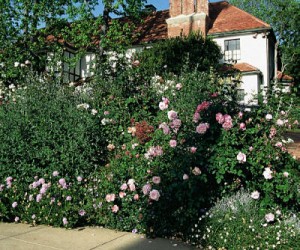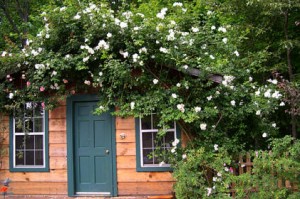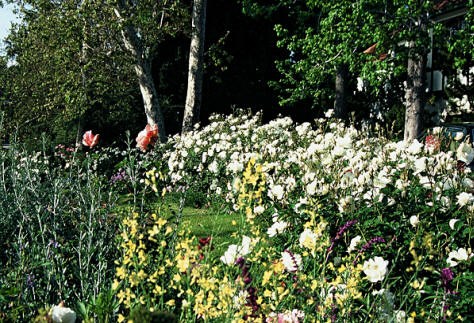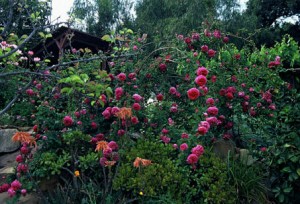Paul F. ZimmermanThis article has appeared in various forms in
The American Rose Society 2000 Annual
Perennial Magazine – 2003
And a few others.
A man walks into a nursery and asks, “I’m looking for a flowering shrub that comes in a lot of different colors and sizes, is fragrant, blooms all year that I can mix with a bunch of other plants. Got any suggestions?” The Nursery Person puts a finger to His/Her lips and quietly motions for the man to follow Him/Her. He/She leads the man by the azaleas, around the camellias and down past the viburnums. Turning the corner He/She points to a huge section of flowering shrubs in all shapes and sizes with an overwhelming fragrance. The man takes one look, turns to the Nursery Person and says, “but these are roses”. The Nursery Person says, “I know, they make great landscape shrubs. But don’t tell anyone
because you’ll make rosarians really mad.”
A bit extreme perhaps but it illustrates my point that most of us consider roses to be nothing more than a flower factory. Too many of us go out, buy a bunch of rosebushes and pay no attention to how and where we plant them. Then as long as they do not get disease and the flowers keep coming, we are happy. What we end up with is a row of little soldiers all proudly wearing epaulets on their shoulders but unfortunately the overall look sometimes leaves much to be desired. Perhaps you’ve seen a bed of roses with the odd Floribunda and Grandiflora thrown in making the rose garden look like an out of balance skyline. Roses are great shrubs and should take their place proudly in the garden with the other plants. After all, how many other shrubs are there that give color all year 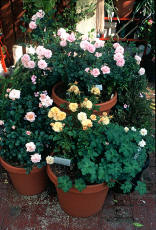 around? Well, there is the hibiscus but for those of us who live in the 48 states that cannot grow them we will stick to roses. So try not to think of your rose bushes as a separate entity from the rest of the garden.
around? Well, there is the hibiscus but for those of us who live in the 48 states that cannot grow them we will stick to roses. So try not to think of your rose bushes as a separate entity from the rest of the garden.
So where do we begin? First, I am going to break the roses down by growth habit. This way you can pick a rose by where you need it in the garden. Not unlike the method used by many gardening books in selecting perennials.
The types of growth habit I use are upright, sprawling, and climbing. Upright bush’s growth habit goes straight up and the blooms tend to be on top of the canes. Ala a lot of the Portlands. Sprawling are the bushes where the canes go out away from the center and bend over to the ground. They bear flowers all along the cane. Most Bourbons fit into this category. Climbers scramble along fences, walls and trellis. I then subdivided these categories by height: small, medium and large. A quick breakdown of the major classes of Roses by growth habit and size goes like this.
| Upright | Sprawling | |
| Ground Cover | Ground Cover | |
| Small Shrub
(3- 4’. Front of the Border) |
Miniature
China Tea Polyantha |
|
| Medium Shrub
(4’-6’. Middle of the Border) |
Floribunda
Portland Some English Centifolia Damask |
Hybrid Rugosa |
| Large Shrub
(6’ plus. Back of the Border) |
Grandiflora
Hybrid Perpetual Some English Grandiflora Hybrid Gallica Moss Alba |
Some English
Bourbon Hybrid Eglanteria Hybrid Musk |
| Small Climber
(6’-8’. 4’ fences and short pillars like mailbox posts) |
Climbing Miniatures
Climbing China Climbing Polyantha |
|
| Medium Climber
(6’-12’. Arbors, 8’ pillars and 6’ fences) |
Sprawling Bourbon
Sprawling English Climbing Floribunda Some Hybrid Musk |
|
| Large Climber
(12’-20’. Pergolas, long runs of fence) |
Large Flowered Climbers
Noisettes Climbing Teas Climbing Bourbons |
|
| Rambler
(20’ plus. Trees, large fences, banks & hillsides) |
Hybrid Banksia
Hybrid Bracteata Hybrid Gigantea Hybrid Multiflora Hybrid Wichurana |
|
| Hedging | Floribunda
Grandiflora Hybrid Perpetual Polyantha Portland Alba Hybrid Gallica |
|
| Pots | Miniatures
Floribundas China Tea Polyantha Some English |
You may notice the “Shrub” class is missing from the chart. Unfortunately, this class is a catchall class for all kinds of different roses. There are shrubs that fit every occasion but you need to evaluate them individually. All rose catalogues and websites have information on sizes of the individual shrubs so let that be your guide.
Okay, now that we know how the roses are going to grow we need to figure out where to plant them. To make this easier I would like you to think of roses a little differently. Instead of thinking of them as roses, think of them as just another flowering shrub. That is right, just like a forsythia, a hydrangea, an azalea etc. these roses are used the same way in your garden.
Roses need sun, so that is the first consideration we will take into account. What is full sun for a rose? Not as much as you think. Full sun is a minimum of 7 hours a day as long as it is morning sun. If they can get sun all day that is better, but at least 7 hours of morning sun is enough. I do not advise you plant roses in an area that does not get sun until the afternoon. The only class of roses that can take less sun or dappled light are the Hybrid Musks. Here is a little planting tip when trying to put a rose into dappled light. Do not take it out of the pot. Just dig a hole the size of the pot, stick the pot with the rose in the ground and watch it. You will know within six weeks or so if the rose is happy, because the leaves will still be healthy and will continue to
bloom. If it is not happy, simply slip the pot out of the ground and try it somewhere else.
Roses do not like wet feet so make sure the place you plant them has decent drainage. This brings us to water needs. Roses like infrequent deep watering, which means when you water, water deeply and then let them dry out a little before the next watering. Obviously, rainfall has its own agenda, but figure that ¼” of rain is the same as a good watering. Anything less does not count.
A myth I would like to debunk here is the one about getting the leaves wet. Hogwash! What are you going to do when it rains – run out there with umbrellas? Overhead watering is fine and in fact, we do it all the time here at the nursery. It is a great way to keep fungus down by washing off the spores. It is when you overhead water that matters. Do it in the morning, not in the evening. That way the leaves can dry off before fungus kicks in.
Once you have locations picked out that fulfill these two requirements let your imagination run wild. The easiest possibility is in the border with your other shrubs and perennials. Roses enhance any part of a classic English flower border.
But how about growing roses on pillars? This is a great way to add either vertical interest to the garden and/or to grow some of the climbers in a small space. A pillar rose is nothing more than a rose grown on some kind of vertical support like a wooden 4”x4”, a wrought iron structure o
r bamboo poles – the list goes on. Simply plant the rose at the base of the pillar, wrap the canes barber pole style around it and when the rose gets to the top, simply let it fountain off.
Roses make great security fences. All the ramblers, if grown unsupported will slowly mound up into a very thick and in the case of the thorny ones, a very vicious barrier to anything you do not want in your yard.
The ramblers are also great for covering long stretches of fences. I like to layer them in with repeat blooming climbers. All the ramblers have great foliage so by layering them and repeating climbers together you get a great spring display when all of them bloom, and then the repeaters continue to bloom through the fall against the luscious foliage of the ramblers. For an extra kick, grow autumn blooming clematis in there.
Have a hillside you are tired o
f mowing or keeping down with the weed eater. Think roses. Ramblers like the Lady Banks Roses will root all along the canes and hold most any hillside. Pop in some big rose shrubs for color and you will not need to bother with the hillside again.
For other places to grow roses think hedges, tumbling over rock walls, edging along a walkway, mass planting at the foot of the driveway – the list is limited only by your imagination. However, what I hope you are beginning to understand is roses are a lot more versatile than you think.
Once the rose is planted and growing, it will not mind a little care, but not as much as rose books would have you think. First, let us talk about pruning. These kinds of roses do not like being pruned hard so do not do it. At most, you can shape them by taking off no more than 1/3rd of the mature size of the plant. Feel free to do this during any part of the season, but right after they have a bloom flush is the best. In the case of climbers, shaping is a little different.
Climbers on arbors, walls and fences can get messy in that they send out long shoots off the main branches that grow in complete disorder. The key to keeping climbers tidy is knowing what you can and cannot cut. First, do not cut the main canes. These are the long canes coming from the base of the plant. You can tip them back using the no more than 1/3rd rule, but that is it. However, the laterals are a different story. These are the “branches” coming off the main cane and you can cut them back to within 12” of the main cane at most anytime – best is again right after they bloom. Simply follow this rule and your climbers will remain tidy.
All plants like feeding and roses are no exception. However, start by feeding the soil – and not with chemicals. Feed it with organics. Composted horse manure, mushroom compost, and your own compost – all these work to build a healthy soil. In addition, make sure you add compost yearly – not just when you plant. Think of a forest floor. Every year the leaves fall and turn to compost. Mother Nature does not come through with a giant leaf blower and clean up every fall. No, she knows the best thing is to keep rejuvenating the soil on a yearly basis. You need to do the same.
As to feeding during the year, keep it simple. I find the following works great for any home garden. In spring when the new growth is about 1” long, scatter ½ cup each of Epson salts and a long-term fertilizer (like Osmocote) around each bush. Put your compost on and, if you wish a decorative mulch on top. That is it! Come late summer, when the roses are starting to push towards their fall bloom you can add some short-term plant food for the fall push. Do not use long-term fertilizer in the fall. The last thing you want to do is pump the roses full of nitrogen while they are trying to go dormant. If you want to do some liquid feeding during the year, by all means do, but with this feeding method you will not have to.
Lastly, let us talk fungus and bugs. The thing to remember about these vigorous landscape roses is regardless of how much fungus they get, or how bad the Japanese Beetles get them, they are hearty enough to grow out of it. So, if you want to spray you can, but if you are out of town or do not have time do not worry about it. However, any kind of treatment starts with healthy plants. Just like people, a healthy plant has a better chance of fighting off disease so keep that soil healthy.
In the case of fungus, you treat them differently depending on if you want to prevent it, or you already have it. The former you treat with preventatives, the latter with eradicants. Preventatives are almost all chemical based and systemic. That is, they are absorbed into the plant. Check with your local garden center as to what is available in your area and what they feel works best.
If you have fungus and you want to get rid of it then you need an eradicant. Most chemical ones are pretty lethal and I do not advise them for the home gardener. There are natural
choices that work and we recommend going this route.
First is baking soda. Baking soda does a good job of killing disease spores once they land on your roses. The mixture is simple. 1 tbs per gallon of water of each of the following; Baking Soda, Canola Oil, Insecticidal Soap and White Vinegar. Be careful when you mix it, because it sometimes foams up, but once you get them all dissolved together simply spray it on your roses using whatever spray applicator you normally use.
Secondly is using a product known as dormant lime and sulfur. It comes as a liquid concentrate and it is how you use it that counts. Mix at the rate of 1tbs per gallon of water. Spray on your roses (it will not hurt other plants) either early in the morning before the sun is way up or on a cloudy day (you want to avoid sunburn). Wait about 30 minutes and then wash it all off with water. Sulfur is a great eradicant for any kind of fungus. I have used it for years with great success.success.
In addition, the “Safer” company offers a great line of natural insecticidal soaps and fungicides. They all work well and we recommend them.
For bugs all the insecticidal soaps work well as does simply blasting them off with water. There is another product out there called Neem Oil that is working well in all kinds of trials. A good Garden Center will have it or it is available mail order from companies like Gardens Alive (www.gardensalive.com). Always remember to follow the instructions and never apply more than the recommended dosage of any insecticide or fungicide – natural or not.
I hope this encourages everyone who loves gardening, but has stopped growing or has never grown roses, to try them. These shrub roses are easy to care for, they give great bloom, come in all shapes and colors and best of all have wonderful fragrance (well, most of them). What more can you ask for from a plant.
Paul F. Zimmerman
Ashdown Roses Ltd
November 7, 2003
